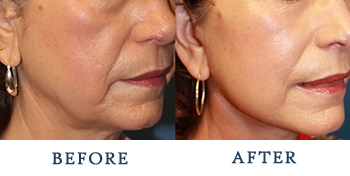Also Serving Facelift and Neck Lift Patients in Everett & Bellingham
A face and neck lift can help you look years younger by subtly tightening the skin and underlying tissues of the face and neck. A face lift is often combined with fat removal and tightening of the two muscles just under the skin in the neck. It improves your appearance from the cheeks down, including the jawline.
At Cascade Facial Surgery, Dr. Jonathan Grant treats every patient as a unique individual. Your surgical plan is designed specifically to address the result you want within the parameters of sound and safe medical practices.
Dr. Grant’s training and experience as a reconstructive facial surgeon allows him to evaluate your face and neck to determine the best way to recontour your face and neck for a natural-looking result.
Some patients have a brow lift or eyelid surgery along with a face and neck lift to address signs of aging above the cheeks. We also sometimes recommend that face and neck lift patients have fractional laser skin resurfacing at the same time or after they have healed from surgery. This treatment addresses the fine surface lines and wrinkles that cannot be alleviated with a surgical procedure.
I recently had a Signature Facelift and upper and lower Blepharoplasty. Before making this important decision, I researched thoroughly what it would entail. I was nervous about perhaps looking... Read More »
Who is a Candidate for a Face and Neck Lift?
Candidates for a face and neck lift are those who have signs of aging on the face from the cheeks to the neck, including:
- Jowls (a sagging jawline)
- Aging around the cheeks
- Nasolabial folds (from the nose to the mouth)
- Marionette lines (from the mouth to the chin)
- Double chin
- Excess fat and loose skin on the neck
- Muscle bands on the neck (sometimes called “turkey neck”)
Most candidates for a face and neck lift are between the ages of 40 and 70.
Benefits of A Facelift
A facelift can make you look like a younger and more vibrant version of yourself. Instead of simply pulling loose skin taut, Dr. Grant lifts and tightens the facial and neck structural tissues, repositions displaced fat and trims excess skin. This produces results that look subtle and natural — never artificial or frozen.
The surgery itself is performed on an outpatient basis, so you can go home right after the procedure. Thanks to modern techniques and technology, the procedure is usually tolerated extremely well and most patients recover within a few weeks. Dr. Grant is meticulous when planning and placing incisions for scars that are virtually imperceptible.
Facelift Costs
Because Dr. Grant tailors each facelift to the individual needs of the patient, the cost of each facelift varies. When you meet with Dr. Grant for a consultation, our team can provide a breakdown of the costs you can expect to incur for your procedure. This breakdown should include Dr. Grant’s fees as well as the cost of the facility, anesthesia and any recovery essentials.
Facelift is a cosmetic procedure and therefore is not covered by most insurance plans. However, our office does accept financing options through CareCredit, a leading medical lender.
Facelift Results
 Facelift is a long-lasting surgery, but it cannot stop the aging process permanently. Traditional facelift can produce results that can be seen for about 10+ years, with mini facelift lasting between five and seven years. You can maximize your results by practicing good skin care, such as not smoking, wearing sunscreen when outdoors, and applying moisturizer daily. Most patients remain good candidates for further facial rejuvenation procedures if they are unhappy with signs of aging in the future.
Facelift is a long-lasting surgery, but it cannot stop the aging process permanently. Traditional facelift can produce results that can be seen for about 10+ years, with mini facelift lasting between five and seven years. You can maximize your results by practicing good skin care, such as not smoking, wearing sunscreen when outdoors, and applying moisturizer daily. Most patients remain good candidates for further facial rejuvenation procedures if they are unhappy with signs of aging in the future.
Facelift Testimonials
“I had been looking for a facelift surgeon for years. I am so happy with every aspect of my experience with Dr. Grant and the entire staff. They did not miss one detail from start to finish — I would give 10 stars if I could! I get up every morning and really love to look at myself in the mirror again!” – Leslie D.
“I really like my lower neck and facelift. It is conservative, which is what I wanted. Everyone in the office is super nice and I would for sure recommend Dr. Grant for this procedure.” – T.
“Other surgeons I met with were generalists, doing everything from face to full body surgery, but Dr. Grant only does face and neck. It made sense to me to go with a doctor with the most experience and expertise with face and neck surgery, and boy did I make the right decision! Dr. Grant and his team took great care of me, and my results are natural beautiful!” – Binny F.
Understanding the Face and Neck Lift Procedure
Dr. Grant will examine you during your consultation and discuss your concerns about your face and neck. Then, he can devise a surgical plan for you.
During the consultation, we often use the Canfield Mirror imaging software to simulate how your face and neck can change with surgery.
A face and neck lift is an outpatient procedure that can sometimes be performed using IV anesthetic and sedation, while some patients may require general anesthesia. You will be able to go home on the same day as your surgery.
For a traditional face and neck lift, an incision is made within the hairline from the temple around the backs of the ears, as well as an incision under the chin. Excess skin is removed, and the underlying tissues are tightened and lifted to a more youthful position. If necessary, liposuction is performed to remove excess fatty tissue. The skin is then redraped and sutured.
Mini Facelift
A mini-facelift involves a shorter incision, usually behind the ears, and primarily tightens the jawline. Some improvements can be seen in the neck, but it does not lift the neck as aggressively as a traditional lift. Some mini-facelift procedures can be done with local anesthetic alone.
For those who only have signs of aging on the neck, an isolated neck lift can be performed with an incision under the chin. This procedure alone does not improve the jawline, however.

Recovering From a Face and Neck Lift
You can expect to need approximately two weeks off from work after a face and neck lift. Please avoid sports and exercise for three to six weeks.
After all surgeries, there is some pain, tightness, and swelling. Some patients also experience some mild bruising. These symptoms are to be expected. You will wear a wrapping around your head, and you will have drains inserted behind the ears to catch excess fluids overnight after surgery. We will remove these the day after surgery.
You can take pain medication, and we will give you instructions how to take care of your face and neck during this time. Sleeping upright or on your back with your head elevated for a couple of weeks will help to keep swelling to a minimum. We will give you instructions for showering, washing your hair, and cleaning your suture line areas.
Note that swelling is the last symptom to resolve. It can take weeks and sometimes months for you to see the final results of your surgery. Your scars will evolve and mature for up to a year after surgery. Most of our patient’s remark that the recovery period is easier than they expected and well worth the results.
Frequently Asked Questions About Facelift
How long does a facelift surgery take?
The total treatment time depends on the scope of your surgery. Dr. Grant can advise how long your surgery will take once the two of you determine your treatment plan.
Is a facelift painful?
No. Anesthesia is used during surgery so you will not feel or remember anything. After surgery, patients are usually pleasantly surprised to discover that any post-operative discomfort is minimal.
Does a facelift improve signs of aging around the eyes?
A Facelift is focused on the mid-face and lower face. However, it can be performed in combination with brow lift and/or eyelid surgery to minimize wrinkles, creases and laxity around the eyes, eyebrows and forehead.
Will smoking affect my results?
If you smoke and you are planning to undergo a facelift surgery, you should quit at least three to six weeks prior to treatment and do your best not to start again after surgery.
Smoking and nicotine in general interfere with your body’s healing progress by limiting blood flow and oxygen to the healing tissues. It puts you at risk of complications such as infection, delayed wound healing, thick scars and increased pain.
Furthermore, smoking accelerates the aging process, which will have an adverse effect on your facelift results.
Will my facelift leave scars?
In a “lower face and neck” facelift, the incisions are placed within the temples, around the backs of the ears and under the chin in natural creases. In a “mini” or simply a “lower face” facelift, shorter incisions are made and there is a very small chin scar (if any at all). As long as you follow Dr. Grant’s incision care instructions, avoid smoking and keep your healing incisions out of the sun, they should heal very well. No one will be able to detect your scars unless they look very closely.
What other procedures can enhance my facelift results?
In-office treatments like Botox® or filler injections can minimize wrinkles and creases around your forehead, eyes, nose or mouth. Filler can also be used to add youthful volume where it has been lost over time.
Other treatments like laser skin resurfacing and chemical peels can reduce pigmentation irregularities and generally improve the tone and texture of the facial skin.
What is the difference between facelift and neck lift?
Neck lift is a surgery that exclusively focuses on smoothing and recontouring the neck. In most of the facelift surgeries that he performs, Dr. Grant incorporates elements of neck lift into the surgical plan since signs of aging often simultaneously appear on the lower face and neck. However, if you have developed skin laxity on your neck while your lower face has minimal wrinkles and jowls, you may be a candidate for just neck lift.
At what age can I have facelift?
 Dr. Grant has performed facelift/neck lift on patients of a variety of ages. Depending on your genetics, skin care routine, and sun exposure, signs of aging may appear before your peers or later in life than expected. While most facelift patients are in their 40s, 50s, and 60s, it is not unusual to seek facial rejuvenation before or after that timeframe. Being in good health and having visible signs of aging that can be reversed with surgery are more important criteria for facelift than your specific age.
Dr. Grant has performed facelift/neck lift on patients of a variety of ages. Depending on your genetics, skin care routine, and sun exposure, signs of aging may appear before your peers or later in life than expected. While most facelift patients are in their 40s, 50s, and 60s, it is not unusual to seek facial rejuvenation before or after that timeframe. Being in good health and having visible signs of aging that can be reversed with surgery are more important criteria for facelift than your specific age.
Is facelift different for men?
Dr. Grant has treated many male and female patients. Although the principles are largely the same, Dr. Grant does adjust some of his techniques when performing facelift on a male patient. As an aesthetic expert, he has a deep understanding of which traits are attractive on a man’s face and which are more appreciated on a woman’s face. With women, Dr. Grant usually creates a soft neckline with smooth skin on the lower face. With men, Dr. Grant’s focus is usually to give extra definition to the jawline for a sharper, more masculine face.
Learn More
If you are interested in a face and neck lift in the Western Washington area, contact us to find out if you’re a good candidate for the procedure.
Contact Us Today!






